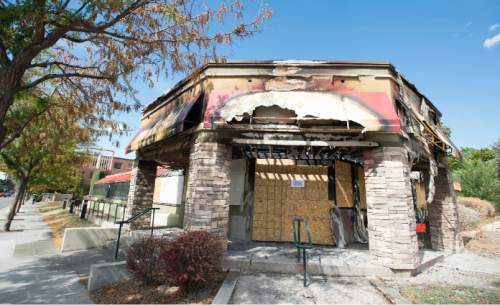This is an archived article that was published on sltrib.com in 2016, and information in the article may be outdated. It is provided only for personal research purposes and may not be reprinted.
The old Sizzler building near the intersection of 400 South and 400 East in Salt Lake City is — well, sizzled.
The one-time steakhouse is now a boarded-up eyesore that once again puts City Hall in the uncomfortable spot of dealing with such structures.
The abandoned building caught fire in the early morning hours of Aug. 12, said Jasen Asay, fire department spokesman. Transients were seen in the area, he said, and the event was ruled human caused. It isn't clear whether the blaze was arson or accidentally set.
Either way, Mayor Jackie Biskupski and the City Council find themselves in somewhat of a quandary, leading to an effort to tweak a 2012 ordinance meant to alleviate such blight. If approved, it could lead to the demolition of the Sizzler building.
That ordinance was crafted in reaction to the "Sugar Hole," the bulldozed remains of the southwest retail corner of 2100 S. Highland Drive in the Sugar House neighborhood that back in 2008 remained vacant for months.
It simply held that a building could not be demolished until the property owner had an approved plan to replace it. The council also adopted language prohibiting property owners from allowing vacant buildings to rot. Such structures must remain "habitable," according to the ordinance.
Beyond the Sizzler, it appears some of Salt Lake City's abandoned buildings don't meet that guideline.
Among the capital city's eyesores are the Zephyr Club building at the southeastern corner of West Temple and 300 South and the Yardstick building on 300 South near State Street. Those structures in the heart of downtown were abandoned years before the 2012 ordinance and, apparently, do not need to comply with the "habitability" aspect of the regulations.
The Sugar House Community Council in 2015 voiced concerns about the abandoned Ute Car Wash at 853 E. 2100 South. At its urging, Biskupski used a little-known aspect of the ordinance that allows the mayor to appoint a committee to determine whether a structure poses a public safety hazard.
A four-member panel found the car wash fell into the "unsafe" category and it was razed with cooperation of the property owner, who has no current plan to rebuild.
Councilwoman Lisa Adams, whose District 7 encompassed the car wash, and District 4 Councilman Derek Kitchen, who represents the area surrounding the Sizzler, said Thursday they are working to retool the city's demolition ordinance so that structures like the Sizzler building can be torn down.
As to the Yardstick and Zephyr, there appears to be little that can be done to urge property owners to develop dilapidated properties that blemish the cityscape. "It boils down to individual property rights versus community good," Kitchen said. "I wish we could incentivize the property owners to do something with them."
No date has yet been set by the council to vote on a makeover of the demolition ordinance.









